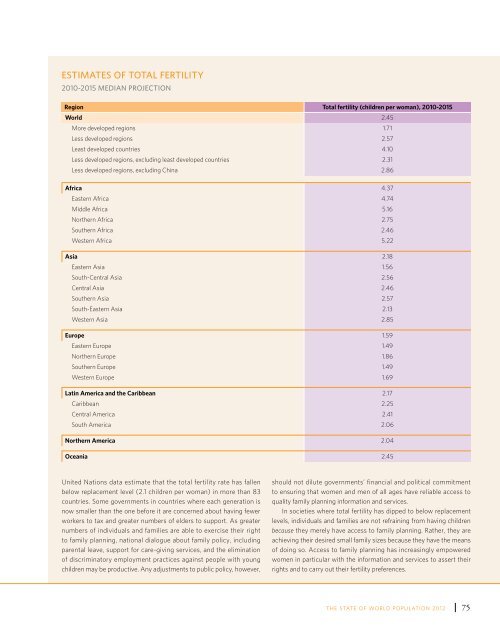State of World Population 2012 - Country Page List - UNFPA
State of World Population 2012 - Country Page List - UNFPA
State of World Population 2012 - Country Page List - UNFPA
You also want an ePaper? Increase the reach of your titles
YUMPU automatically turns print PDFs into web optimized ePapers that Google loves.
Estimates <strong>of</strong> Total Fertility<br />
2010-2015 median projection<br />
Region Total fertility (children per woman), 2010-2015<br />
<strong>World</strong> 2.45<br />
More developed regions 1.71<br />
Less developed regions 2.57<br />
Least developed countries 4.10<br />
Less developed regions, excluding least developed countries 2.31<br />
Less developed regions, excluding China 2.86<br />
Africa 4.37<br />
Eastern Africa 4.74<br />
Middle Africa 5.16<br />
Northern Africa 2.75<br />
Southern Africa 2.46<br />
Western Africa 5.22<br />
Asia 2.18<br />
Eastern Asia 1.56<br />
South-Central Asia 2.56<br />
Central Asia 2.46<br />
Southern Asia 2.57<br />
South-Eastern Asia 2.13<br />
Western Asia 2.85<br />
Europe 1.59<br />
Eastern Europe 1.49<br />
Northern Europe 1.86<br />
Southern Europe 1.49<br />
Western Europe 1.69<br />
Latin America and the Caribbean 2.17<br />
Caribbean 2.25<br />
Central America 2.41<br />
South America 2.06<br />
Northern America 2.04<br />
Oceania 2.45<br />
United Nations data estimate that the total fertility rate has fallen<br />
below replacement level (2.1 children per woman) in more than 83<br />
countries. Some governments in countries where each generation is<br />
now smaller than the one before it are concerned about having fewer<br />
workers to tax and greater numbers <strong>of</strong> elders to support. As greater<br />
numbers <strong>of</strong> individuals and families are able to exercise their right<br />
to family planning, national dialogue about family policy, including<br />
parental leave, support for care-giving services, and the elimination<br />
<strong>of</strong> discriminatory employment practices against people with young<br />
children may be productive. Any adjustments to public policy, however,<br />
should not dilute governments’ financial and political commitment<br />
to ensuring that women and men <strong>of</strong> all ages have reliable access to<br />
quality family planning information and services.<br />
In societies where total fertility has dipped to below replacement<br />
levels, individuals and families are not refraining from having children<br />
because they merely have access to family planning. Rather, they are<br />
achieving their desired small family sizes because they have the means<br />
<strong>of</strong> doing so. Access to family planning has increasingly empowered<br />
women in particular with the information and services to assert their<br />
rights and to carry out their fertility preferences.<br />
THE STATE OF WORLD POPULATION <strong>2012</strong><br />
75
















